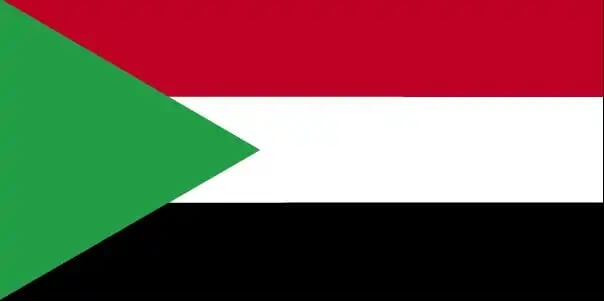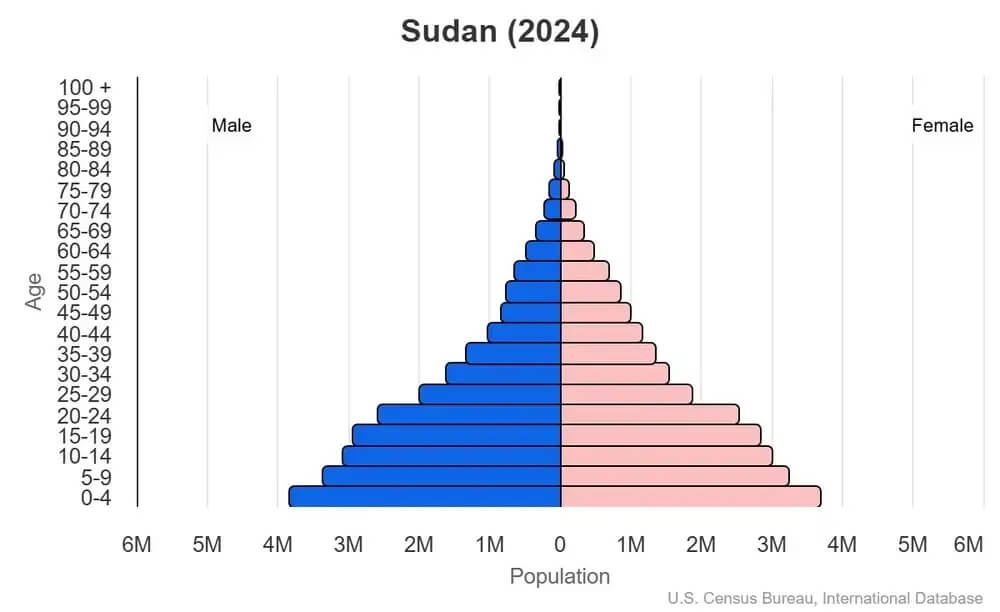World Book
Sudan
World Book Index
46


With a score of 46, the country is ranked 142th out of 158 countries in the World Book ranking. (more information)
Introduction
Background
Between the 14th and 15th centuries, Arab nomads settled much of Sudan, leading to extensive Islamization in the 16th-19th centuries. Since independence from Anglo-Egyptian co-rule in 1956, military regimes favoring Islamic-oriented governments have dominated national politics. South Sudan became independent from Sudan in 2011 after a referendum.
Geography
Area
total : 1,861,484 sq km
land: 1,731,671 sq km
water: 129,813 sq km
Climate
hot and dry; arid desert; rainy season varies by region (April to November)
Natural resources
petroleum; small reserves of iron ore, copper, chromium ore, zinc, tungsten, mica, silver, gold; hydropower
People and Society
Population
total: 50,467,278 (2024 est.)
Ethnic groups
Sudanese Arab (approximately 70%), Fur, Beja, Nuba, Ingessana, Uduk, Fallata, Masalit, Dajo, Gimir, Tunjur, Berti; there are over 500 ethnic groups
Languages
Arabic (official), English (official), Nubian, Ta Bedawie, Fur
Religions
Sunni Muslim, small Christian minority
Population growth rate
2.55% (2024 est.)
Government
Government type
presidential republic
Capital
name: Khartoum
Executive branch
chief of state: Sovereign Council Chair and Commander-in-Chief of the Sudanese Armed Forces General Abd-al-Fattah al-BURHAN Abd-al-Rahman (since 11 November 2021)
head of government: Sovereign Council Chair and Commander-in-Chief of the Sudanese Armed Forces General Abd-al-Fattah al-BURHAN Abd-al-Rahman (since 11 November 2021)
Diplomatic representation in the US
chief of mission: Ambassador Mohamed Abdalla IDRIS (since 16 September 2022)
Diplomatic representation from the US
chief of mission: Ambassador (vacant); Chargé d'Affaires Colleen Crenwelge (since May 2024)
Economy
Economic overview
low-income Sahel economy devastated by ongoing civil war; major impacts on rural income, basic commodity prices, industrial production, agricultural supply chain, communications and commerce; hyperinflation and currency depreciation worsening food access and humanitarian conditions
Real GDP (purchasing power parity)
$94.42 billion (2024 est.)
$109.147 billion (2023 est.)
$154.672 billion (2022 est.)
Real GDP per capita
$1,900 (2024 est.)
$2,200 (2023 est.)
$3,100 (2022 est.)
Exports
$5.908 billion (2022 est.)
$6.664 billion (2021 est.)
$5.065 billion (2020 est.)
Exports - partners
UAE 21%, China 17%, Saudi Arabia 16%, Malaysia 9%, Egypt 8% (2023)
Exports - commodities
crude petroleum, gold, oil seeds, sheep and goats, ground nuts (2023)
Imports
$11.575 billion (2022 est.)
$10.271 billion (2021 est.)
$10.52 billion (2020 est.)
Imports - partners
China 21%, India 19%, Egypt 16%, UAE 14%, Saudi Arabia 7% (2023)
Imports - commodities
raw sugar, wheat flours, refined petroleum, garments, packaged medicine (2023)
Human Development Index
The country's Human Development Index (HDI) is 0.511, ranking it 176th out of 193 countries tested. (more information)
World Happiness Report
The World Happiness Report ranked the country 134th out of 158 countries tested with a score of 4.139. (more information)



